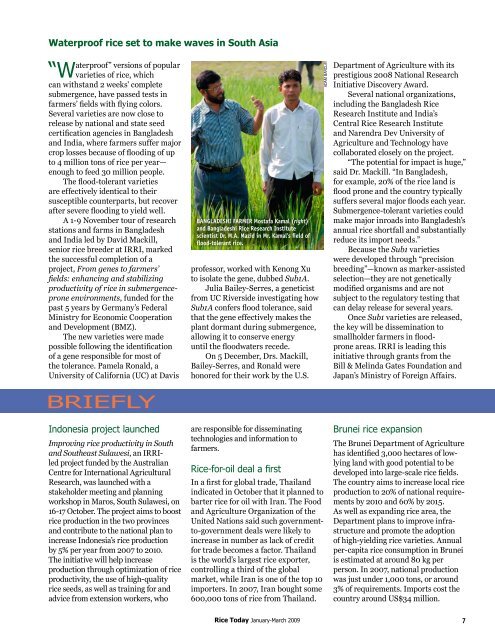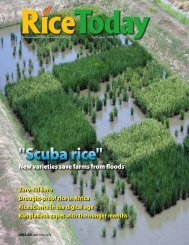How much water does rice need? - adron.sr
How much water does rice need? - adron.sr
How much water does rice need? - adron.sr
You also want an ePaper? Increase the reach of your titles
YUMPU automatically turns print PDFs into web optimized ePapers that Google loves.
Waterproof <strong>rice</strong> set to make waves in South Asiaaterproof” versions of popular“Wvarieties of <strong>rice</strong>, whichcan withstand 2 weeks' completesubmergence, have passed tests infarmers’ fields with flying colors.Several varieties are now close torelease by national and state seedcertification agencies in Bangladeshand India, where farmers suffer majorcrop losses because of flooding of upto 4 million tons of <strong>rice</strong> per year—enough to feed 30 million people.The flood-tolerant varietiesare effectively identical to theirsusceptible counterparts, but recoverafter severe flooding to yield well.A 1-9 November tour of researchstations and farms in Bangladeshand India led by David Mackill,senior <strong>rice</strong> breeder at IRRI, markedthe successful completion of aproject, From genes to farmers’fields: enhancing and stabilizingproductivity of <strong>rice</strong> in submergenceproneenvironments, funded for thepast 5 years by Germany’s FederalMinistry for Economic Cooperationand Development (BMZ).The new varieties were madepossible following the identificationof a gene responsible for most ofthe tolerance. Pamela Ronald, aUniversity of California (UC) at DavisBANGLADESHI FARMER Mostafa Kamal (right)and Bangladeshi Rice Research Institutescientist Dr. M.A. Mazid in Mr. Kamal’s field offlood-tolerant <strong>rice</strong>.professor, worked with Kenong Xuto isolate the gene, dubbed Sub1A.Julia Bailey-Serres, a geneticistfrom UC Riverside investigating howSub1A confers flood tolerance, saidthat the gene effectively makes theplant dormant during submergence,allowing it to conserve energyuntil the flood<strong>water</strong>s recede.On 5 December, Drs. Mackill,Bailey-Serres, and Ronald werehonored for their work by the U.S.adam barclayDepartment of Agriculture with itsprestigious 2008 National ResearchInitiative Discovery Award.Several national organizations,including the Bangladesh RiceResearch Institute and India’sCentral Rice Research Instituteand Narendra Dev University ofAgriculture and Technology havecollaborated closely on the project.“The potential for impact is huge,”said Dr. Mackill. “In Bangladesh,for example, 20% of the <strong>rice</strong> land isflood prone and the country typicallysuffers several major floods each year.Submergence-tolerant varieties couldmake major inroads into Bangladesh’sannual <strong>rice</strong> shortfall and substantiallyreduce its import <strong>need</strong>s.”Because the Sub1 varietieswere developed through “precisionbreeding”—known as marker-assistedselection—they are not geneticallymodified organisms and are notsubject to the regulatory testing thatcan delay release for several years.Once Sub1 varieties are released,the key will be dissemination tosmallholder farmers in floodproneareas. IRRI is leading thisinitiative through grants from theBill & Melinda Gates Foundation andJapan’s Ministry of Foreign Affairs.Indonesia project launchedImproving <strong>rice</strong> productivity in Southand Southeast Sulawesi, an IRRIledproject funded by the AustralianCentre for International AgriculturalResearch, was launched with astakeholder meeting and planningworkshop in Maros, South Sulawesi, on16-17 October. The project aims to boost<strong>rice</strong> production in the two provincesand contribute to the national plan toincrease Indonesia’s <strong>rice</strong> productionby 5% per year from 2007 to 2010.The initiative will help increaseproduction through optimization of <strong>rice</strong>productivity, the use of high-quality<strong>rice</strong> seeds, as well as training for andadvice from extension workers, whoare responsible for disseminatingtechnologies and information tofarmers.Rice-for-oil deal a firstIn a first for global trade, Thailandindicated in October that it planned tobarter <strong>rice</strong> for oil with Iran. The Foodand Agriculture Organization of theUnited Nations said such governmentto-governmentdeals were likely toincrease in number as lack of creditfor trade becomes a factor. Thailandis the world’s largest <strong>rice</strong> exporter,controlling a third of the globalmarket, while Iran is one of the top 10importers. In 2007, Iran bought some600,000 tons of <strong>rice</strong> from Thailand.Brunei <strong>rice</strong> expansionThe Brunei Department of Agriculturehas identified 3,000 hectares of lowlyingland with good potential to bedeveloped into large-scale <strong>rice</strong> fields.The country aims to increase local <strong>rice</strong>production to 20% of national requirementsby 2010 and 60% by 2015.As well as expanding <strong>rice</strong> area, theDepartment plans to improve infrastructureand promote the adoptionof high-yielding <strong>rice</strong> varieties. Annualper-capita <strong>rice</strong> consumption in Bruneiis estimated at around 80 kg perperson. In 2007, national productionwas just under 1,000 tons, or around3% of requirements. Imports cost thecountry around US$34 million.Rice Today January-March 2009

















